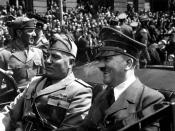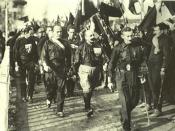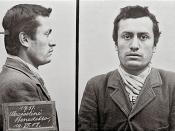Fascism today is certainly a controversial term, capable of stirring up emotions and starting a heated debate. Possibly because of its controversial nature in many ways it is difficult to define. The term itself is often used to describe someone else's beliefs rather than ones own and is frequently seen as an insult. Fascism in general refers to a number of movements that existed in Europe during the 20's and 30's. However, most of the groups involved rejected the label and claimed to be unrelated to each other. Although many political leaders have been labeled "fascist" during the past few decades this paper will introduce and emphasize the concept of fascism in Europe prominently from the pre world war one era until the end of world war two.
Fascism, broadly defined, is seen as a political ideology that holds the interests of the state above that of its people as a whole.
It proposes to create a national unity whose core principles focus on culture, race, and religion. Fascist states tend to be very patriotic, militaristic, and totalitarianistic. The word fascism originated during the rule of Italian dictator Benito Mussolini between the years 1922 -1943. Mussolini used it as a symbol for strength through unity. The word itself is a combination of the Italian word fascio and the Latin term for fasces. In The Doctrine of Fascism, Mussolini wrote "Anti-individualistic, the fascist conception of life stresses the importance of the State and accepts the individual only insofar as his interests coincide with those of the State, which stands for the conscience and the universal will of man as a historic entity....".
Benito Mussolini was the prime minister ruling Italy beginning in 1922. His fascist regime was the father of all subsequent forms of fascism. Using a combination of censorship and...


